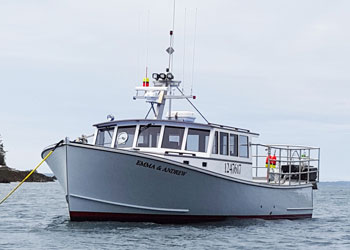Ben Weed – Lobsterman
by Sandra Dinsmore

Ben launched his 44-foot John’s Bay lobster boat, Emma & Andrew, named after his now eight-year-old daughter and six-year-old son, nine years later, in 2013. The Emma & Andrew takes Ben out 40 miles to the end of Area 1. Richard Stern photo.
Thirty-two-year-old Deer Isle lobsterman Ben Weed first stepped into a boat at age four. He fished his first traps at eight, though he admits he couldn’t haul them. One of his parents had to do that. He’s a third generation lobster fisherman on his father’s side. His father’s father started lobstering after he retired as a carpenter and a stonecutter. His mother’s father graduated from high school at age 16. “Left right from the graduation,” Ben said, “got on a sardine carrier and was gone.” Ben’s wife, Melissa, also comes from a fishing family.
An uncle gave Ben his first skiff when he was in third grade—a 12-footer he could run by himself. By fifth grade he had outgrown the skiff, so his father built him a 22-foot outboard. “I guess that’s when I first started to take off,” Ben said, but then admitted that for the first few years his mother would go with him in summer and fall. He doesn’t remember how many traps he hauled back then, but thinks it might have been 300.
By the time he bought his 32-foot South Shore Diamond Girl, Ben had his license, so he guesses he was 16 or 17. He had Diamond Girl for two years. He would have been in 10th or 11th grade by then, and could only fish after school, weekends, and summers.
An uncle gave Ben
his first skiff when he
was in third grade.
Ben took advantage of Deer Isle-Stonington High School’s Marine Trades Program, a marvelous course of study for future fishermen that includes the business aspect of fishing, now called the Skippers Program. This program is only available in a few Maine high schools. (Daughter Emma, now eight, will be taking the Apprentice Program this year, and will be working with ten traps. According to Ben, her brother is jealous because he has to wait two more years till he’s old enough to be in the program, too.)
Although he completed all four years and graduated from high school (in 2004), Ben said he didn’t care about any other aspect of school. “Marine Trades is what I wanted to do,” he said. “I got a lot out of it, but wish I had done more.” He then added that he learned the most about fishing from his father.

“There’s more gear now; the catch was increasing and I needed more capacity, so I spread out to get away from other fishermen; also I was going a long way for a 36-foot boat, and it was getting dangerous, so I built a bigger boat for safety and for comfort.” Richard Stern photo.
The winter after Ben graduated, the then 18-year-old and his father built Ben’s 36-footer, the Majestic. By then he was fishing the full 800 traps. Actually, he can’t remember when exactly he started fishing 800. “It’s a milestone,” he said. “I should remember.” Ben’s father has property at Deer Isle’s Southeast Harbor, so all the fishermen in his family got started fishing from that property.
Ben launched his 44-foot John’s Bay lobster boat, Emma & Andrew, named after his now eight-year-old daughter and six-year-old son, nine years later, in 2013. The Emma & Andrew takes Ben out 40 miles to the end of Area 1, as he puts it, “chasing the lobster.” Ben needs two sternmen to help him fish lobster efficiently from a vessel that large.
Asked why he has fished from increasingly larger boats, Ben gave a number of reasons: “There’s more gear now; the catch was increasing and I needed more capacity, so I spread out to get away from other fishermen; also I was going a long way for a 36-foot boat, and it was getting dangerous, so I built a bigger boat for safety and for comfort.”
Ben fishes offshore. In June he brings his gear home and has only a month to go over everything to get it ready to start again in July when he sets it out by fishing pairs of traps in Deer Isle’s Jericho Bay. In August and September, he’s starting to rig trawls for fishing in deeper water. He keeps moving his gear farther and farther out until he reaches the end of Area 1. The process takes seven months.
“This is where the third man comes in,” Ben observes of moving to deep water, adding, “I try to find someone good rather than just a warm body.” He said, “I keep them on year round so I have them when I need them. It makes sense.” He said, “It’s a hard job to get ahead when you’re busy training them.” He also noted that it’s important for his sternmen to work as a team. When you have trained sternmen, Ben says, “You get on the boat and you don’t have to talk. Everybody knows their job and knows the routine.”
Ben and his sternmen went to school together. He has had one of his sternmen for ten years, and said,” He knows more than I know what to do. We kind of mesh pretty good together. I’ve got him broke in the way I like to have my stuff done.” He then admitted, “I’m kind of fussy.”
He’s up at 2 a.m.,
on the boat at 3,
and doesn’t get home
till 7 or 8 at night.
Melissa, Ben’s wife, agreed that her husband is fussy, saying, “His sternmen have to be on time, be dependable and be able to do the job well and fast.”
Asked what it is he’s fussy about, Ben replied, “Everything: Being on time—If you aren’t going to be there, don’t show up.” He then quoted the old adage, ‘Time and tide wait for no man.’ He then repeated what Melissa had said about being dependable and doing the job well and fast. “Take your time,” he said, “but do it was fast as you can. The more you can do in a day, the more you’re going to catch.”
Ben fishes year round. Asked about how cold he must get in January, he lobsterman admitted, “My feet get cold,” but said he has poor circulation and explained, “I’m standing on the boat, not doing much.”
From October to June Ben hauls 400 traps a day, but said he has hauled as many as 600 traps in a day. “This time of year,” he said in early June, “I don’t do it in less than a week. It costs so much to go,” he observed, adding that the price was down at the moment. “I’m hauling through once a week,” he reported. “Right now, I haul through, put a load on, and come home.”
In summer he hauls twice a week on three- to four-night sets, but said, “From summer through January I’m trying to get every day I can.” In January he hauls only once a week. It’s a 16- to 18-hour day: he’s up at 2 a.m., on the boat at 3, and doesn’t get home till 7 or 8 at night. It takes a couple of hours to ride out to where he fishes and then another couple of hours to get back in. But he explained, “I’m driving, so the sternmen are getting the bait ready, the boat ready, getting everything kind of set up to go, then on the way home they’re cleaning and putting stuff away. When the sternmen finish what they’re doing, they can go down and take a nap, or whatever.” Asked how often he does this, Ben responded, “One- to- two days a week. That’s 400 traps. If I do that today,” he explained, “then if the weather worked out, I’d do that again tomorrow; then I’d be off three or four days. Then I’d do it again. It kind of goes on the weather. You take what you can get. It’s a long ways to go. The boat gets very small.” Then he added, “Maybe I’m just getting lazy and don’t want to push anymore.”
In summer he’s at it 6 days a week: he leaves at 4 a.m. and is back between 1 and 3 in the afternoon. In October and November he starts to go out further and he’s trying to do the 400 traps a day. “The weather starts to get bad,” he said; “so when you get a break in the weather, you’ve got to make it count. There’s more lobster crawling, better lobsters, so you’re going harder all summer right through January. You’re trying to get every day you can. Then this time of year [June] the catch is dropping. Right now the price is dropping, the catch is dropping, everything is kind of …” and he let the sentence kind of slide away. Then he said, “For me, this is my slow time of year, so I let them set.”
